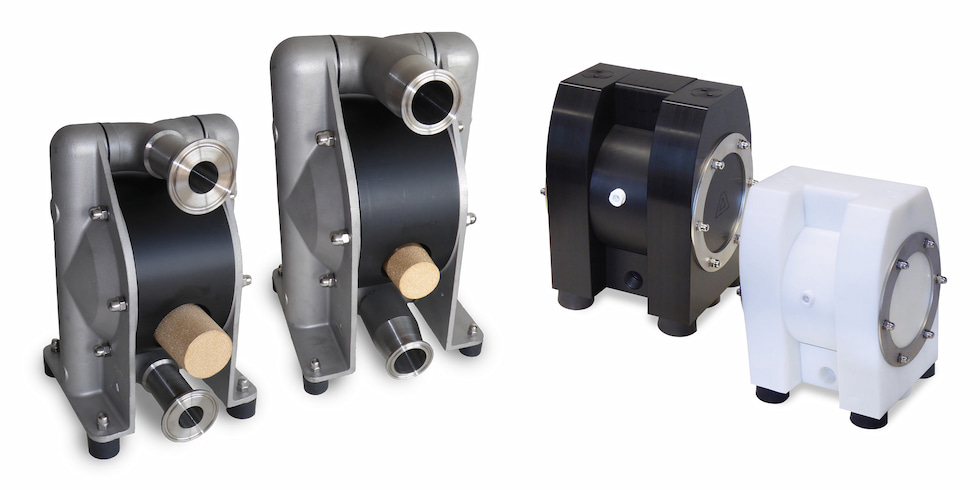
When first learning about air-operated double diaphragm (AODD) pumps, people are left asking how they are able to excel in many diverse applications. The success in this application range, and consequently the popularity of AODD pumps, lies in the pump’s design characteristics.
The first two characteristics—simple startup and self-priming—help explain the flexibility of AODD pumps. Part of this flexibility includes easy installation. Since there is no need to align the pump when changing locations, installation can be performed by standing the pump upright and connecting the fluid lines and air supply. Also, there is no need to prime an AODD pump, so users can avoid the possibly dangerous process—depending on the liquid—of bringing the medium into the pump manually. Instead, the pump fills itself during operation by sucking the medium out of the receiver.
Once in operation, an AODD pump does not require control electronics and/or frequency converters, which might cause the motor temperature to rise during slow running without a forced cooling fan (critical for ATEX—a certification necessary when dealing with explosive atmospheres). Instead, the air volume and the pump flow rate is regulated with a needle valve. If, for example, the density or viscosity changes due to the temperature, the pump will automatically run slower or faster without damage to the pump or without the loss of liquid, as is the case with internal pump slip or a magnetic coupling that can tear during operation. And if the liquid fails to flow, for example, because the tank is empty, it continues to run dry.
Another important design characteristic of the AODD pump is gentle displacement pumping. These pumps allow solids of considerable size to pass through them, resulting in gentle pumping and low shear. And because AODD pumps do not contain any drive parts or other rotating parts within the fluid, there is no need to worry about damaging the shaft seal. Operational risks and the need to maintain mechanical seals (including the use of additives for flushing, etc.) are also eliminated. Instead, a purely static seal takes effect, which is “hermetically sealed,” according to guidelines from the German Technical Guidelines on Air Pollution.
An AODD pump is overload-proof. This means the pump can only build up as much pressure as it is given via the drive air pressure, which can be the maximum permissible pressure of the filter. If the outlet pressure reaches the drive air pressure, the pump stops, so there is no danger of the pump or the line bursting if the pressure line is blocked. This results in overload protection for lines/filters and an on-off operation via valves in the medium.
AODD Pump Characteristics
- simple startup
- self-priming capability
- resistant to dry running and running smoothly with solids
- gentle displacement pumping
- continuously adjustable via controllable air volumes
- self-adjusting when the medium changes
- no drives or rotating parts in the pumped medium
- no shaft seals
- overload-proof—if the counterpressure equals the drive-air pressure, the pump stops and restarts when the pressure drops—without regulation or monitoring via mean supply response time (MSRT) devices
- easy to use in hazardous areas (such as for applications with explosive atmosphere [ATEX] conditions)
- current-less drive via compressed air
There is no risk of sparks from an electric drive, self-heating is not an issue and static charges can be dissipated via the pump’s conductive materials (as well as plastic). This makes AODD pumps suited for use in hazardous areas and mobile applications. Light and compact, these pumps can be installed in hazardous areas and operate with stored air in the case of an emergency.
AODD pumps can be manufactured from a range of pump materials and possible combinations. The interior can be manufactured in a large number of elastomers and thermoplastics, from “black rubbers” such as neoprene or Buna-N (nitrile rubber) to polytetrafluoroethylene (PTFE). The pump’s housing can be manufactured in various metals, from cast iron and aluminum to high-grade stainless steels. The housing can also be manufactured in a variety of plastics, including high-performance plastics such as PTFE or polyether ether ketone (PEEK).
Therefore, depending on the mechanical/chemical properties or the temperature of the medium, the pump can almost always adapt to the application. And since the pump is constructed in a solid-block design, it provides additional design advantages when it comes to safety, including high stability and rigidity, static weight, and chemical-resistant surfaces.

